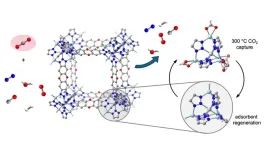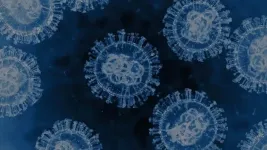New study in Science finds that just four global policies could eliminate more than 90% of plastic waste and 30% of linked carbon emissions by 2050
Released on eve of UN plastic treaty negotiations in Busan, South Korea, comprehensive study reveals that an ambitious treaty can nearly eliminate plastic pollution — a threat to people, wildlife and the climate
2024-11-14
(Press-News.org) Berkeley, CA/Santa Barabara, CA (14 November 2024) — A new study released in Science today determines that just four policies can reduce mismanaged plastic waste — plastic that isn’t recycled or properly disposed of and ends up as pollution — by 91% and plastic-related greenhouse gasses by one-third. The policies are: mandate new products be made with 40% post-consumer recycled plastic; cap new plastic production at 2020 levels; invest significantly in plastic waste management — such as landfills and waste collection services; and implement a small fee on plastic packaging. This policy package also delivers climate benefits, reducing emissions equivalent to taking 300 million gasoline-powered vehicles off the road for one year.
The study, “Pathways to reduce global plastic waste mismanagement and greenhouse gas emissions by 2050,” by researchers at the University of California Berkeley and the University of California Santa Barbara, comes in advance of negotiations in Busan, Republic of Korea (November 25-December 1), where delegates from more than 190 countries are expected to iron out the final details of the world’s first legally binding treaty on plastic pollution.
“This is it. These upcoming negotiations in Busan are our one chance to come together as a planet and fix this problem,” said Dr. Douglas McCauley, Professor at UC Santa Barbara, Adjunct Professor at UC Berkeley. “One of the most exciting discoveries in this research is that it is actually possible to nearly end plastic pollution with this Treaty. I'm cautiously optimistic, but we can’t squander this once-in-a-lifetime opportunity.”
If no action is taken in Busan, annual plastic consumption will rise 37% between 2020 and 2050, and plastic pollution will nearly double across the same period.
“This study demonstrates how far we have come in not just quantifying the manifold problems surrounding plastics, but also in identifying and evaluating potential solutions,” said Dr. Roland Geyer, Professor of Industrial Ecology, Bren School of Environmental Science & Management at UC Santa Barbara. “I am very proud of what our team was able to achieve in time for the final round of negotiations for the Global Plastics Treaty.”
By continuing with business as usual, the world would generate enough litter between 2011 and 2050 to cover Manhattan in a heap of plastic ten times the height of the Empire State Building. In a business-as-usual future, greenhouse gas emissions related to plastic would jump 37% from 2020 levels to 3.35 gigatons of carbon dioxide equivalent in 2050 — this is the same as nearly 9,000 natural gas-fired power plants operating for one year or the energy use for more than 436 million homes for one year.
“There are multiple pathways available to negotiators, but it does require ambition,” said Sam Pottinger, Senior Research Data Scientist, Eric and Wendy Schmidt Center for Data Science and Environment at UC Berkeley. “The impact that we're really hoping to see on the treaty is that it is data-informed. As the treaty comes to its final conclusion before ratification, we want folks to be aware of how much progress they've actually made, at least according to the best science that we have available right now.”
Countries in the Global South will continue to bear the greatest burden of the plastic crisis. Financing mechanisms created in the treaty could drive much-needed investment into waste management and recycling infrastructure in these regions to reduce plastic pollution — thus helping to solve a major global environmental justice issue.
“I’m optimistic about a sustainable future,” said Dr. Nivedita Biyani, Researcher on Global Plastic Modeling, Benioff Ocean Science Laboratory at UC Santa Barbara. “This policy work shows that we can reach minimal mismanaged plastic waste if we can come together in action. This provides policymakers with a novel tool that isn’t prescriptive — they can combine various policies as they see fit. Going forward, I think a mechanism to gather data on plastic production and trade will be a key factor. We need supply chain transparency here."
The study is built on insights from an AI-generated tool developed by a team of plastic researchers, data scientists, and AI researchers at the Benioff Ocean Science Laboratory and Bren School of Environmental Science & Management at University of California Santa Barbara, and the Eric and Wendy Schmidt Center for Data Science & Environment at University of California Berkeley. The tool uses machine learning to combine information about population growth and economic trends to forecast the future of plastic production, pollution and trade.
###
Available for Interviews:
Dr. Douglas McCauley, Professor, UC Santa Barbara, Adjunct Professor, UC Berkeley
Dr. Roland Geyer, Professor of Industrial Ecology, Bren School of Environmental Science & Management at UC Santa Barbara
Dr. Nivedita Biyani, Researcher on Global Plastic Modeling, Benioff Ocean Science Laboratory at UC Santa Barbara
Mr. A Sam Pottinger, Senior Research Data Scientist, Eric and Wendy Schmidt Center for Data Science and Environment at UC Berkeley
Mr. Neil Nathan, Marine Science and Policy Specialist, Benioff Ocean Science Laboratory at UC Santa Barbara
END
ELSE PRESS RELEASES FROM THIS DATE:
2024-11-14
Industrial plants, such as those that make cement or steel, emit copious amounts of carbon dioxide, a potent greenhouse gas, but the exhaust is too hot for state-of-the-art carbon removal technology. Lots of energy and water are needed to cool the exhaust streams, a requirement that has limited adoption of CO2 capture in some of the most polluting industries.
Now, chemists at the University of California, Berkeley, have discovered that a porous material can act like a sponge to capture CO2 at temperatures close to those of many industrial exhaust streams. ...
2024-11-14
Gene therapy can effectively treat various diseases, but for some debilitating conditions like muscular dystrophies there is a big problem: size. The genes that are dysfunctional in muscular dystrophies are often extremely large, and current delivery methods can’t courier such substantial genetic loads into the body. A new technology, dubbed “StitchR,” surmounts this obstacle by delivering two halves of a gene separately; once in a cell, both DNA segments generate messenger RNAs (mRNAs) that join seamlessly together to restore expression of a protein that is missing or inactive in disease.
Published in ...
2024-11-14
New research suggests that it could be possible to separate treatment from hallucinations when developing new drugs based on psychedelics. The anti-anxiety andhallucination-inducing qualities of psychedelic drugs work through different neural circuits, according to research using a mouse model. The work is published Nov. 15 in Science.
The research shows that decoupling the beneficial effects of psychedelics from their hallucinogenic effects isn’t just a matter of chemical compound design. It’s a matter of targeted neural circuitry.
“In the past, we did this using chemistry by making new compounds, but here we focused on identifying the circuits responsible ...
2024-11-14
UNIVERSITY PARK, Pa. — Microorganisms — bacteria, viruses and other tiny life forms — may drive biological variation in visible life as much, if not more, than genetic mutations, creating new lineages and even new species of animals and plants, according to Seth Bordenstein, director of Penn State’s One Health Microbiome Center, professor of biology and entomology, and the Dorothy Foehr Huck and J. Lloyd Huck Endowed Chair in Microbiome Sciences. Bordenstein and 21 other scientists from around the world published a paper in the leading journal Science, summarizing research that they said drives a deeper understanding of biological ...
2024-11-14
Ghent, November 15, 2024 – Understanding how roots grow can help us develop plants that, for example, are more resistant to drought. Research by Prof. Bert De Rybel’s team (VIB-UGent), in collaboration with the VIB Screening Core and Ghent University, uncovers how roots go through a puberty phase, which could have important implications for developing climate-resilient agriculture. Their work appears in Science.
Plant puberty
Plants, like all living organisms, transition through various developmental stages, starting as a seed, becoming a shoot, and eventually a full-grown, fertile plant. They even go through a sort of ‘puberty’ ...
2024-11-14
Hydrogen is set to play an important role in a future low-carbon economy. However, the hydrogen value chain comes with a set of emissions challenges that need to be addressed for hydrogen deployment to help achieve climate goals. A study prepared by the Research Institute for Sustainability – Helmholtz Centre Potsdam (RIFS) with support from Environmental Defense Fund Europe evaluates the potential impact of climate-warming emissions in Germany’s future hydrogen economy and provides recommendations for German and EU policymakers on how to avoid them.
There are hopes that hydrogen can become a carbon neutral alternative to fossil ...
2024-11-14
For decades, Disney animations have shaped perceptions of family relationships and gender roles. Although much focus has traditionally been on princesses and female characters, a new study shifts attention to fatherhood and the evolving ideals of masculinity.
"In the history of Disney films, female characters and princess imagery have been widely analyzed, yet the role of masculinity has been explored far less. My research aims to deepen our understanding of the male ideals Disney has constructed and how they reflect ...
2024-11-14
Most people think of coffee cups, bathroom tiles or flower pots when they hear the word "ceramic". Not so Frank Clemens. For the research group leader in Empa's Laboratory for High-Performance Ceramics, ceramics can conduct electricity, be intelligent, and even feel. Together with his team, Clemens is developing soft sensor materials based on ceramics. Such sensors can "feel" temperature, strain, pressure or humidity, for instance, which makes them interesting for use in medicine, but also in the field of soft robotics.
Soft ceramics – how is that supposed to work? Materials ...
2024-11-14
About The Study: This study found significant rate increases for alcohol-induced liver disease-related hospitalizations and liver transplants across sex and age groups between 2005 and 2021. Although older males had the highest absolute increases, the greatest relative increases occurred in younger individuals, particularly females.
Corresponding Author: To contact the corresponding author, Michele Molinari, MD, MSc, email molinarim@upmc.edu.
To access the embargoed study: Visit our For The Media website at this link ...
2024-11-14
About The Study: This systematic review and network meta-analysis found that spinal cord stimulation therapies for treatment of chronic pain in back and/or lower extremities were associated with greater improvements in pain compared with conventional medical management. These findings highlight the potential of spinal cord stimulation therapies as an effective and valuable option in chronic pain management.
Corresponding Author: To contact the corresponding author, Konstantinos Soulanis, M.Sc., email konstantinos.soulanis@iqvia.com.
To access ...
LAST 30 PRESS RELEASES:
[Press-News.org] New study in Science finds that just four global policies could eliminate more than 90% of plastic waste and 30% of linked carbon emissions by 2050
Released on eve of UN plastic treaty negotiations in Busan, South Korea, comprehensive study reveals that an ambitious treaty can nearly eliminate plastic pollution — a threat to people, wildlife and the climate



